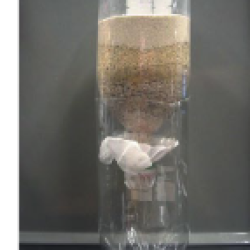Source Institutions
Source Institutions
Add to list Go to activity
Activity link broken? See if it's at the internet archive

Water treatment on a large scale enables the supply of clean drinking water to communities. In this activity, learners develop methods to clean a polluted water sample, describe components of a water treatment process, and learn how humans impact Earth's freshwater supply. The activity simulates methods used in real water treatment including aeration, coagulation, sedimentation, filtration and disinfection. This activity would be an excellent adjunct to a guided tour of a local water treatment plant.
- 10 to 30 minutes
- 45 to 60 minutes
- $5 - $10 per group of students
- Ages 11 - adult
- Experiment/Lab Activity, Simulation
- English
Quick Guide
Materials List (per group of students)
- 16-oz cup of dirty water sample
- measuring spoon and cups
- two coffee filters
- two rubber bands
- one table
- cotton fabric or cheesecloth
- funnels
- paper towels
- screen remnants
- nylon stockings
- plastic containers of various sizes
- 2-liter dirty water sample
- three 2-liter colorless plastic soda bottles
- 2 tbsp. alum powder
- large spoon
- clock with second hand or stopwatch
- one 2-liter colorless plastic soda bottle
- 1.5 cups coarse sand
- 1.5 cups fine sand
- 1 cup small pebbles
- 2 liters clean tap water
- student journals and writing tools
Subjects
-
Earth and Space Science
-
Earth Structure
- Oceans and Water
-
Earth Structure
-
Engineering and Technology
-
Engineering
- Environmental Engineering
-
Engineering
-
Life Sciences
-
Ecology
- Human Impact
-
Ecology
-
Physical Sciences
-
Chemistry
- Chemistry of Life
- Solutions
-
States of Matter
- Liquids
-
Chemistry
-
The Nature of Science
-
The Scientific Process
- Conducting Investigations
- Formulating Explanations
- Communicating Results
-
The Scientific Process
-
The Nature of Technology
-
Technology and Society
- Technology and the Environment
-
Technology and Society
Audience
To use this activity, learners need to:
- see
- read
- touch
Learning styles supported:
- Involves teamwork and communication skills
- Uses STEM to solve real-world problems
- Involves hands-on or lab activities
Other
Components that are part of this resource:
Includes alignment to state and/or national standards:
This resource is part of:
Access Rights:
- Free access
By:
Source Collection
- Science After School Consumer's Guide
Rights:
- All rights reserved, State of New Jersey, 2006
Funding Source:
- No Child Left Behind Act of 2001
